Category Archives for Blocking-In
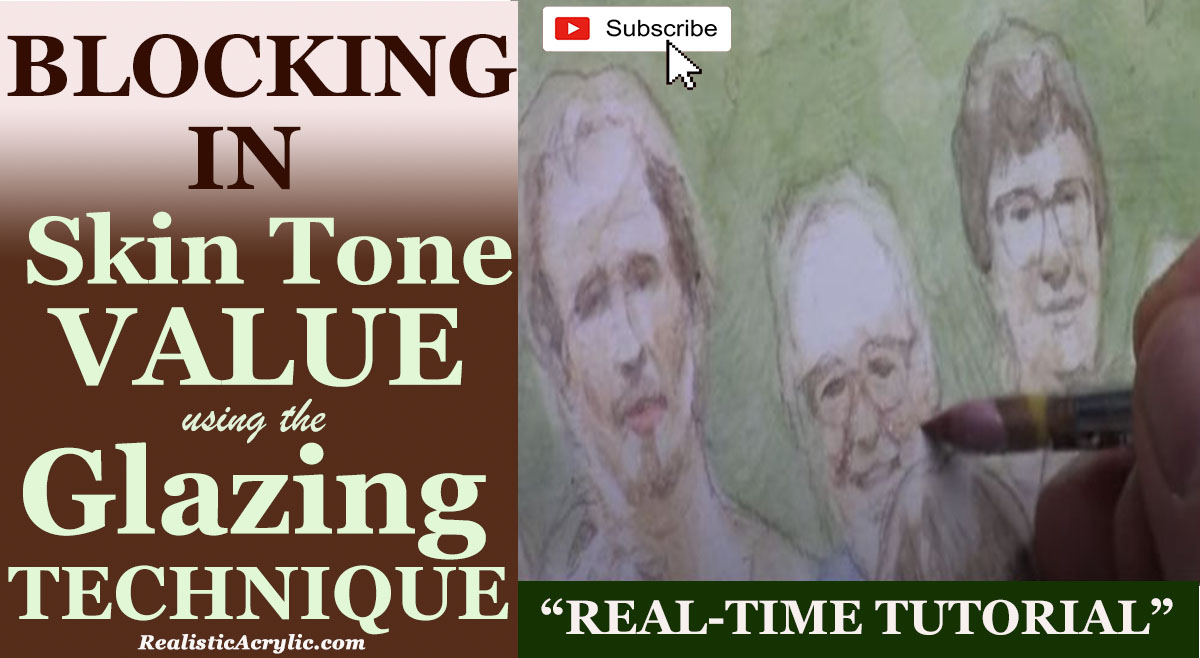
Blocking In Skin Tone Values Using the Glazing Technique
Skin tones can be challenging, as all portrait artists know.
But I’ve discovered that using micro-layers of acrylic, diluted with matte medium, can really help you to build up volume on your faces as you paint. Skin tones and values go hand-in-hand. You always want to be thinking about tonal value (the range of how light and dark a color is) BEFORE you apply it. Then, you want to make sure you apply it in the right place on your face that you’re painting.
Watch my free video tutorial to learn more about the blocking in skin tone values using the glazing technique.
- Adding highlights to your acrylic painting
- 5 Excellent Reasons to Use Aluminum Foil
- Paint Realistic Wrinkles in Acrylic
- Painting Clothing in an Acrylic Portrait
- Paint a Cloudy Sky Acrylic
- How to add Semi-Opaque Highlights
- How to Enhance the Contrast in Your Acrylic
- How to Add Glaze to Your Acrylic Painting
- Paint Realistic Reflections on Eyeglasses in an Acrylic Portrait
- Build Up Depth on Your Acrylic Portrait Backgrounds
- How Do You Do Layers With the Glazing Technique?
- Learn How to Paint Wrinkles in Acrylic
Read more about how to paint a portrait that you can surely be proud of!
I’d love to hear your thoughts on this video. Please share it with your friends and family. Let me know if you have any further questions. I’ll greatly help you.
If you’d like to learn more, sign up for my free email tips and video class today.
Learn How to Paint Acrylic Portraits With My Free Mini-Video Course!
Thank you so much for taking the time to read this tutorial and watch the video. That means a lot to me. I hope you find it very helpful in your portrait painting.
Yours for Better Portraits,

P.S. Did you find this post helpful or encouraging? If so, send it on ahead! Let others know with the share buttons below. I’d love to hear your comments. Thank you so much! Also, do you have a question on acrylic portrait painting you’d like answered? Let me know, and I’d be happy to help!
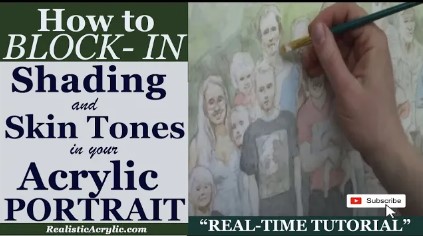
How to Block In Shading and Skin Tones in Your Acrylic Portrait
How do you block in shading and skin tones in acrylic?
Watch my tutorial to learn more about how to block in shading and skin tones in your acrylic portrait.
- Adding highlights to your acrylic painting
- 5 Excellent Reasons to Use Aluminum Foil
- Paint Realistic Wrinkles in Acrylic
- Painting Clothing in an Acrylic Portrait
- Paint a Cloudy Sky Acrylic
- How to add Semi-Opaque Highlights
- How to Enhance the Contrast in Your Acrylic
- How to Add Glaze to Your Acrylic Painting
- Paint Realistic Reflections on Eyeglasses in an Acrylic Portrait
- Build Up Depth on Your Acrylic Portrait Backgrounds
- How Do You Do Layers With the Glazing Technique?
- Learn How to Paint Wrinkles in Acrylic
Read more about how to paint a portrait that you can surely be proud of!
I’d love to hear your thoughts on this video. Please share it with your friends and family. Let me know if you have any further questions. I’ll greatly help you.
If you’d like to learn more, sign up for my free email tips and video class today.
Learn How to Paint Acrylic Portraits With My Free Mini-Video Course!
Thank you so much for taking the time to read this tutorial and watch the video. That means a lot to me. I hope you find it very helpful in your portrait painting.
Yours for Better Portraits,

P.S. Did you find this post helpful or encouraging? If so, send it on ahead! Let others know with the share buttons below. I’d love to hear your comments. Thank you so much! Also, do you have a question on acrylic portrait painting you’d like answered? Let me know, and I’d be happy to help!
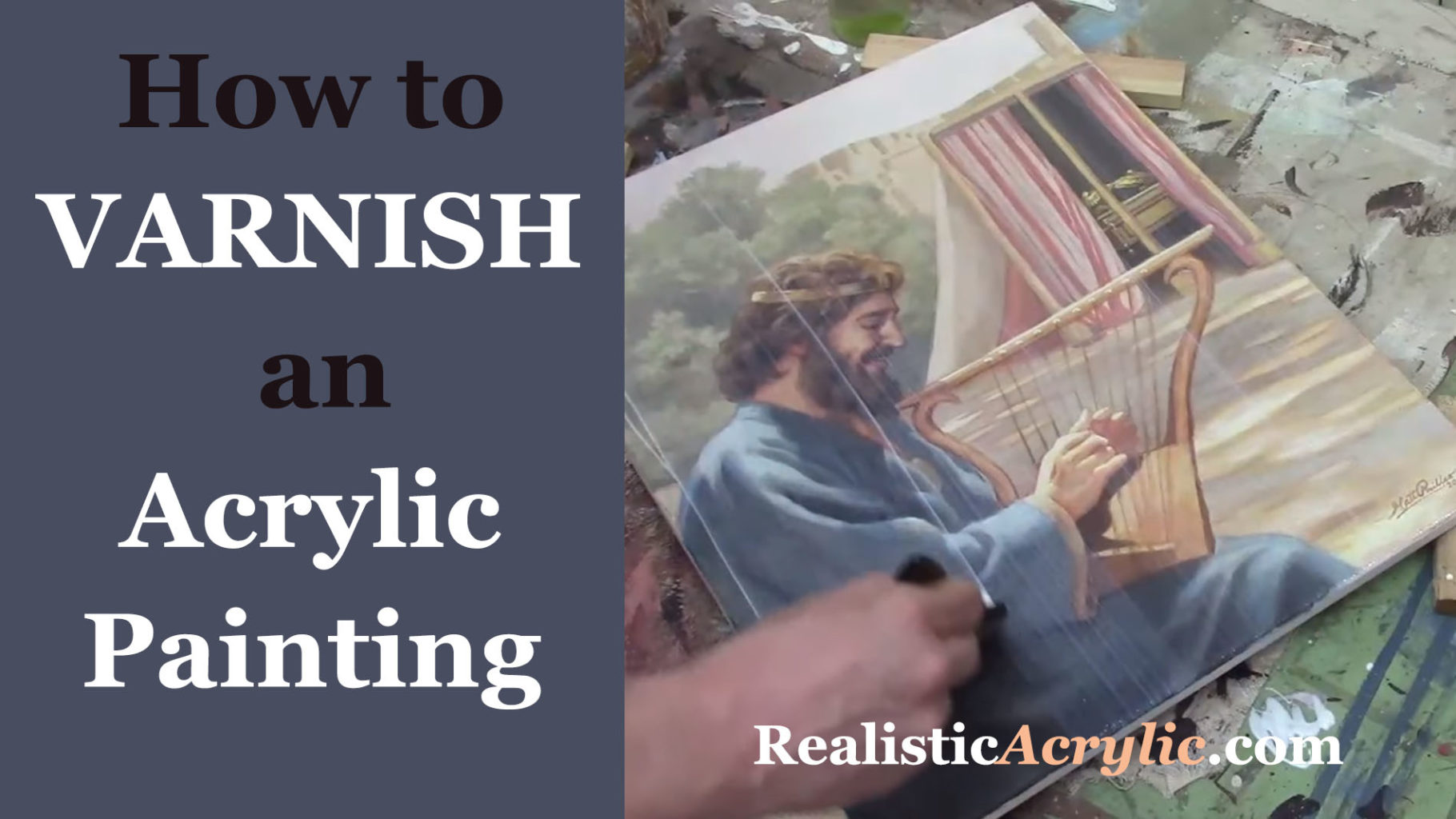
How to Varnish an Acrylic Painting in One Step
A question I get asked a lot is: how do you varnish an acrylic painting?
There’s a lot of controversy surrounding this topic, or at least, many different opinions on how to do it right.
Some say you need an isolation coat. Others say you should spray apply the varnish. And then there are some who pour it on or use a sponge!
I’m not here to dismiss any of those methods. If they work for that particular artist, more power to them.
Rather, I’d like to share with you the method I’ve been using for over 20 years as a portrait painter. It’s easy, and you can do it one step.
Let me break down this one-step acrylic varnishing method into how to actually do it…
- Lay your canvas flat on a table, oriented horizontally, but at an angle.
- Raise your canvas up, on four scraps of wood placed under each corner (make sure it’s level. 1″ x 2″s work well )
- Get your 4″ varnishing brush (Liquitex Freestyle works well)
- Pour matte varnish (Novacolor or Liquitex) into a clean yogurt container or any plastic container large enough to accommodate the width of the brush. Be sure to stir the varnish if it’s been sitting for a while! Over time the polymer resin can separate from the water in the mixture. If you don’t mix it, you may have streaks.
- “Sweep” any dust or debris off of the canvas surface with a large brush before you begin.
- Dip your brush into the varnish container, so the bristles are coated with varnish 1/3-1/2 of the way up from the tip.
- Begin brushing the varnish on the surface, starting with the end farthest from you. Brush in the longest direction of the canvas.
- Let your brush hit 1/3″ of the way from the left edge of the canvas. Apply even pressure and bring the brush all the way to the left edge.
- Bring the brush all the way to the right edge.
- Wipe any excess varnish that remains on your brush inside the top lip of your container.
- Flip the brush over and smooth out the entire first application, overlapping the edge slightly with 1-2 strokes. Do not overbrush!
- Dip your brush into the varnish container and repeat the process. Let your stroke slightly overlap the first (about 1/4″)
- You will be working your way toward your body. This will keep you from accidentally dripping onto the finished varnished surface.
- If you have any extra varnish that drips onto the side of the canvas, use a 3/4 flat brush to wipe it off. If the canvas will be framed, the side-drips are usually not a problem and can be left alone.
- Let your canvas dry flat on a table. It might look milky white in areas. Resist the temptation to brush it! If you followed my method, the varnish should dry crystal clear. It should dry completely within 3-5 hours, depending on humidity.
Disclaimer: I have used this method with great results in over 20 years of portrait painting. Your results are up to you, how you apply this method, and the humidity levels of your studio space. I cannot be held responsible for any painting that gets damaged during the varnishing process. It would be a good idea to varnish a test piece first. You can add another layer (after 3-5 hours of dry time) if you feel the first one didn’t cover as well as you’d like, but most of the time, you won’t need to.
Watch this video below to see the process in action…
Let me know if you have any questions and I look forward to teaching you more!
—Matt
Questions? Suggestions? Thoughts? Let me know, below in the comments. Please share this post with your friends!
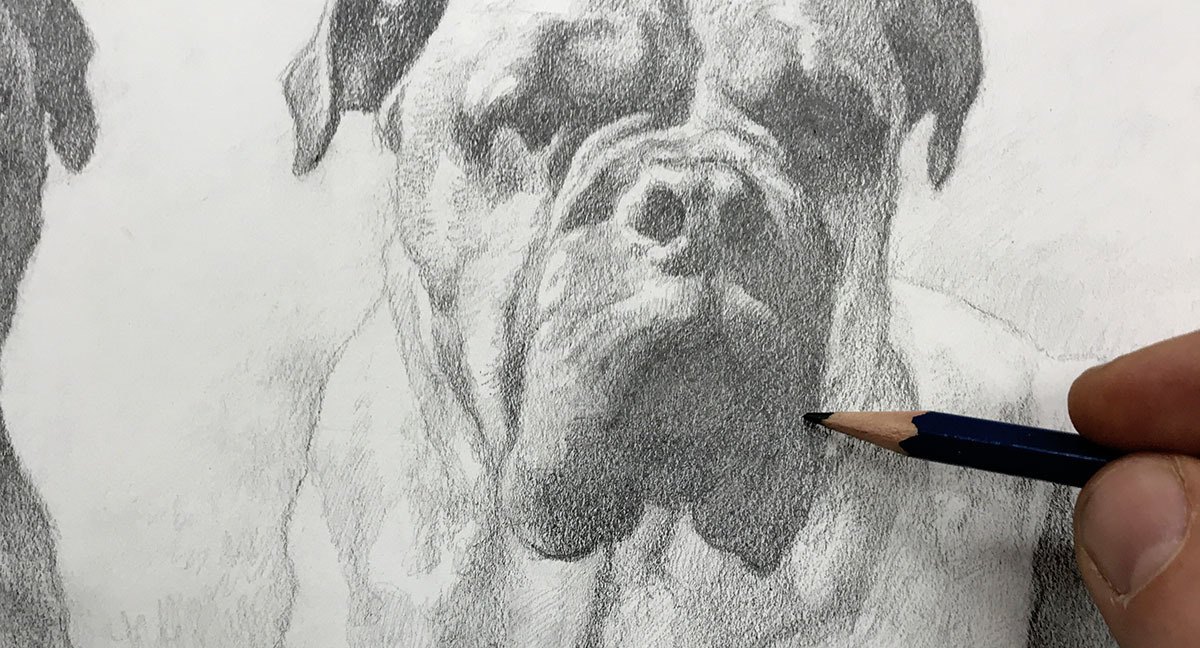
3 Tips to Drawing Better Pencil Portraits
Better drawing=better painting. So today, I’m going to show you some tips on how to improve your drawing.
I’ll be basing today’s demo on an 8″ x 24″ commissioned pet portrait I’m working on. I’ll talk about and demonstrate shading, texture and how to smooth things out.
Watch the video below and find out how to do it!
Let me know if you have any questions and I look forward to teaching you more!
—Matt
Questions? Suggestions? Thoughts? Let me know, below in the comments. Please share this post with your friends!
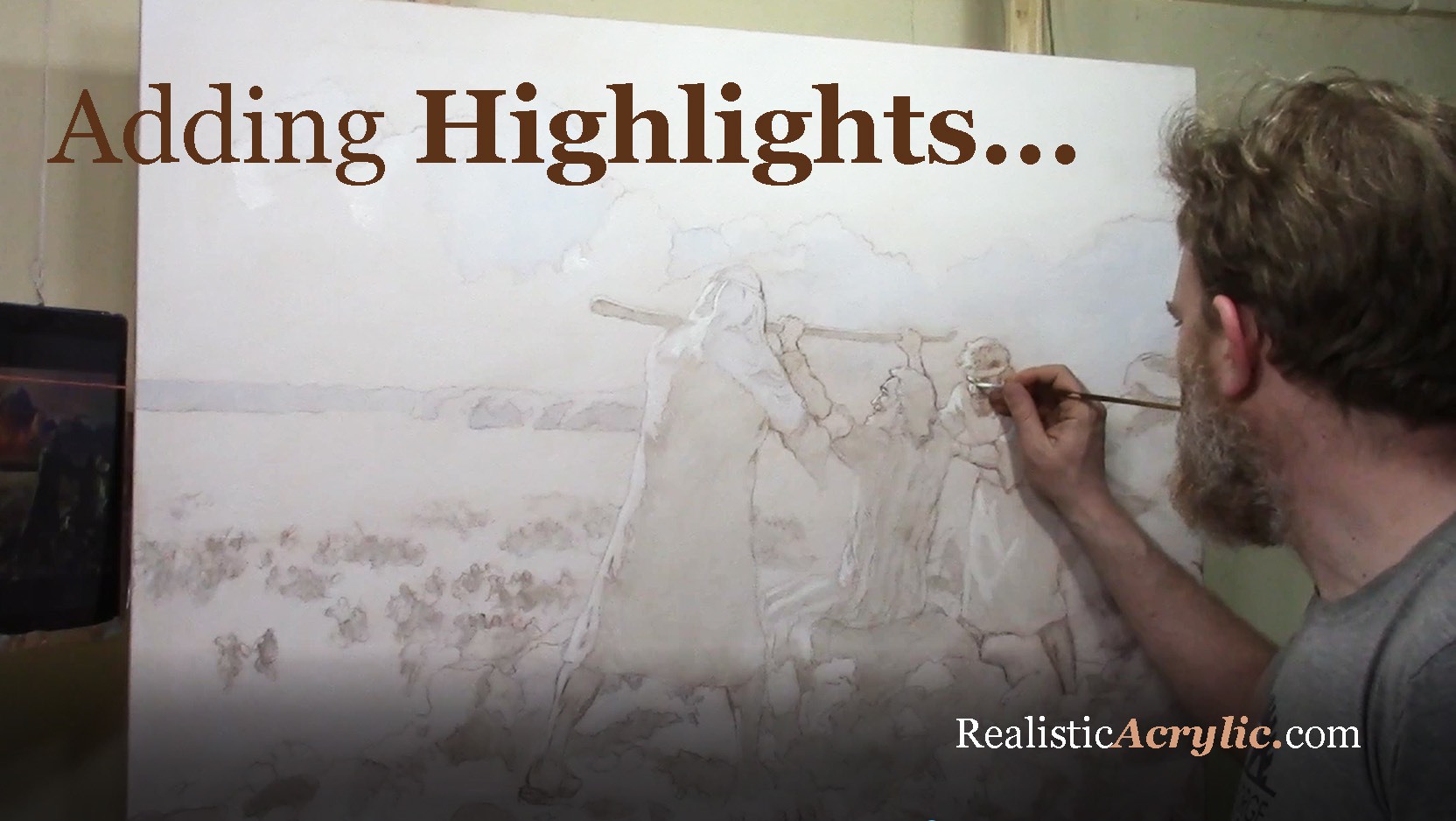
Adding Early Highlights to Your Acrylic Portrait
Sometimes an acrylic painting doesn’t always go the way you want it to go. Then you need to make adjustments. And that’s OK!
In this video, I take a slightly different approach and add highlights to my painting early on in the process. Because my toning layer got a bit dark, I wanted to go back and strengthen the highlights, using titanium white and Indian yellow, diluted with matte medium to make it the application fluid. This allows those areas ultimately to have more luminosity and vibrance.
Let me know if you have any questions and I look forward to teaching you more!
—Matt
Questions? Suggestions? Thoughts? Let me know, below in the comments. Please share this post with your friends!
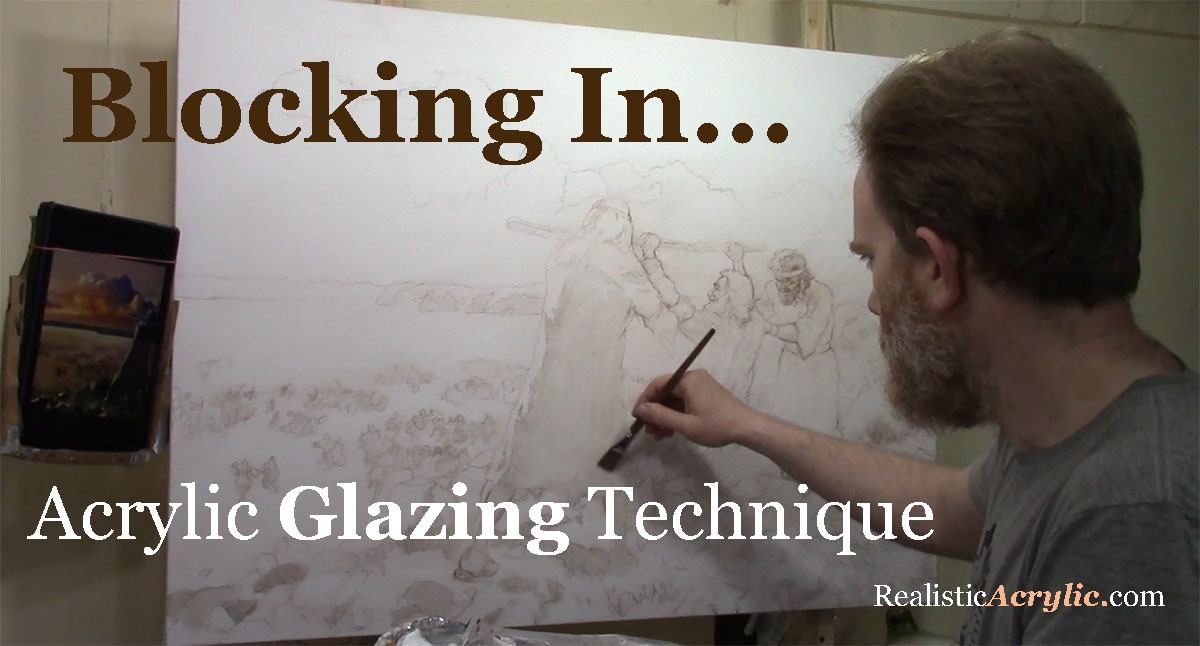
Blocking-in on a 30″ x 40″ Acrylic Battle Scene Painting
The way we begin an acrylic painting is super important and determines, in many ways, how it will end up. In this lesson, I show you how to block in the value structure, using the classical glazing technique adapted for acrylics.
In this demonstration, I am using a 30″ x 40″ acrylic painting I was commissioned to create, a battle scene between ancient Israel and the Amalekites. I asked my friends to come over to my home early in the morning, at sunrise, and model for the painting.
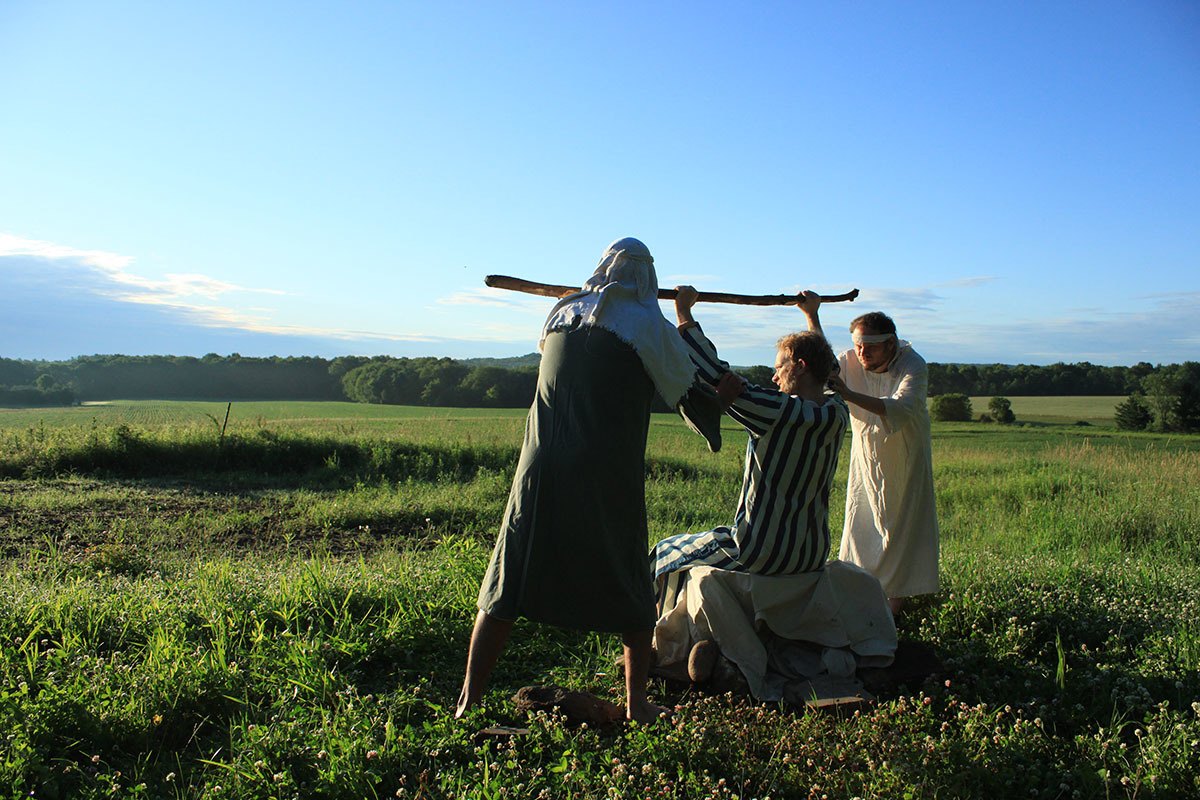
Original reference photo for Moses, Aaron and Hur painting, ©2021 Matt Philleo
Yes, that’s me in the middle!
In this battle, when the Israelite leader Moses held up his staff, the power of God would flow. It caused the Israelite army to defeat their battlefield enemies. But, as the battle lasted for hours, Moses grew tired and couldn’t hold up his staff. Then the Amalekites got the advantage over the Israelites!
His assistants, Aaron and Hur came up with an idea. They had Moses sit on a rock. Then they held up his arms on either side, so once again, the Israelites could prevail.
This painting is meant to depict the struggle in praying, and how when others come alongside of us, they can ease the burden. Their faith strengthens ours, and we can get the victory!
Here is my layout for the painting that I edited on Photoshop…
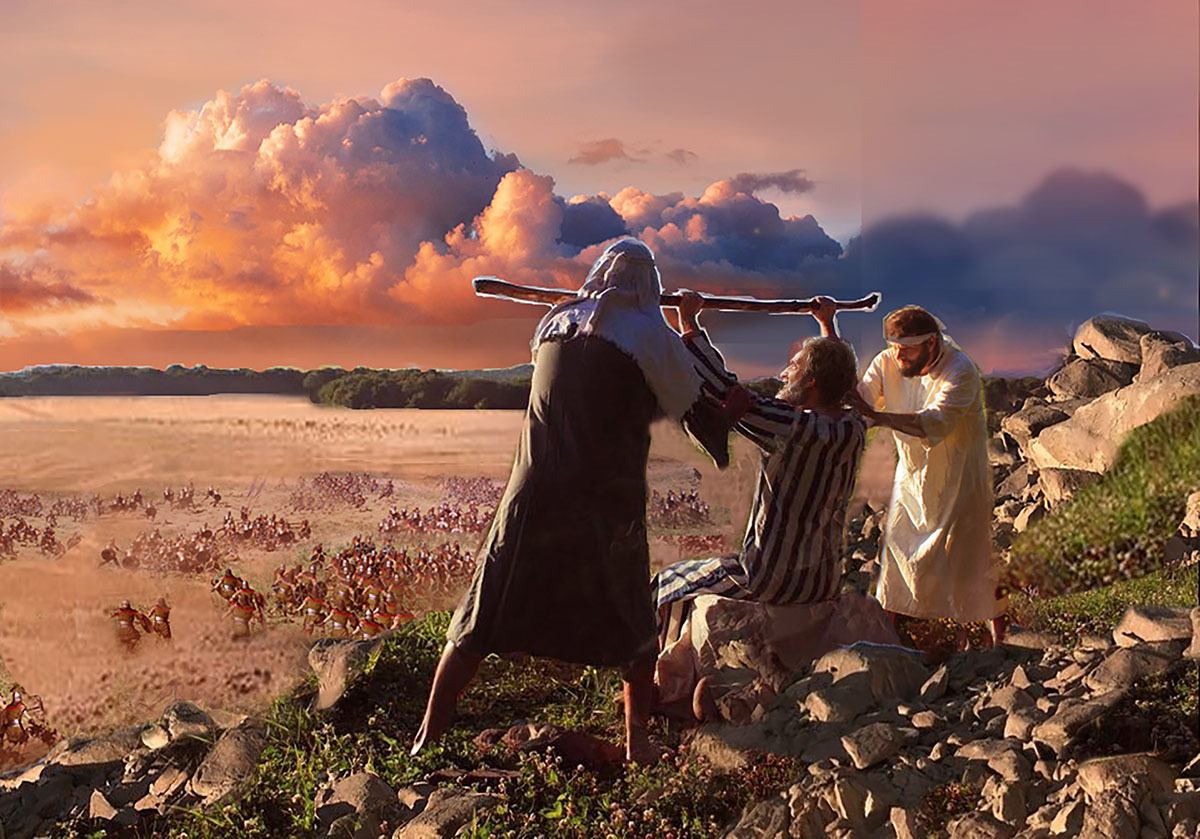
Reference image for acrylic painting of Moses, Aaron and Hur, Battle with the Amalekites, ©2021 Matt Philleo
Now for the blocking-in video…
We start with an accurate sketch. Then, my goal is to quickly identify the major areas of contrast within the reference photo.
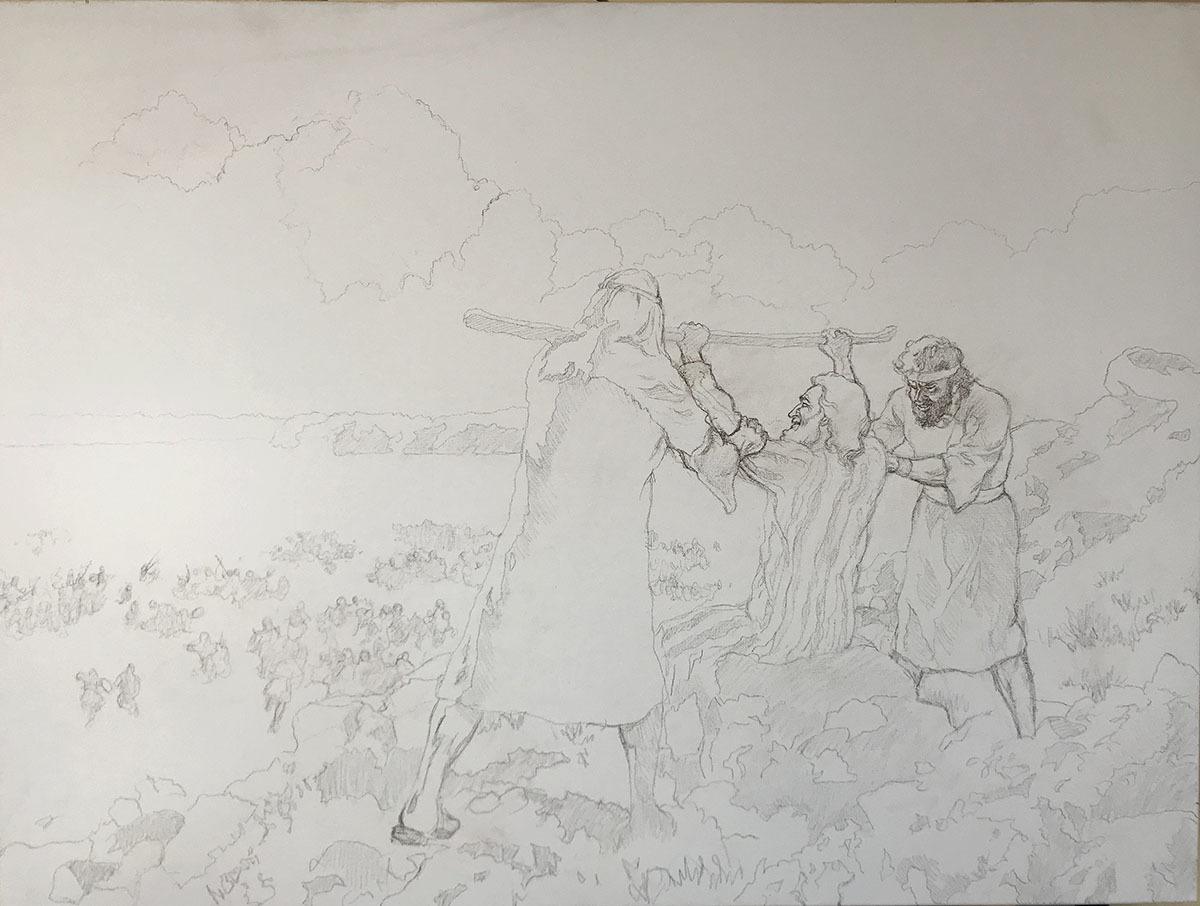
30 x 40 Acrylic on Canvas painting of Moses, Aaron and Hur in the Amalekite battle. Shown in the sketch stage. ©2021 Matt Philleo
Then we apply a layer of raw umber dark, ultramarine blue and matte medium to the shadow areas designated on the sketch…
Watch the video here to see how to do it…
Let me know if you have any questions and I look forward to teaching you more!
—Matt
Questions? Suggestions? Thoughts? Let me know, below in the comments. Please share this post with your friends!
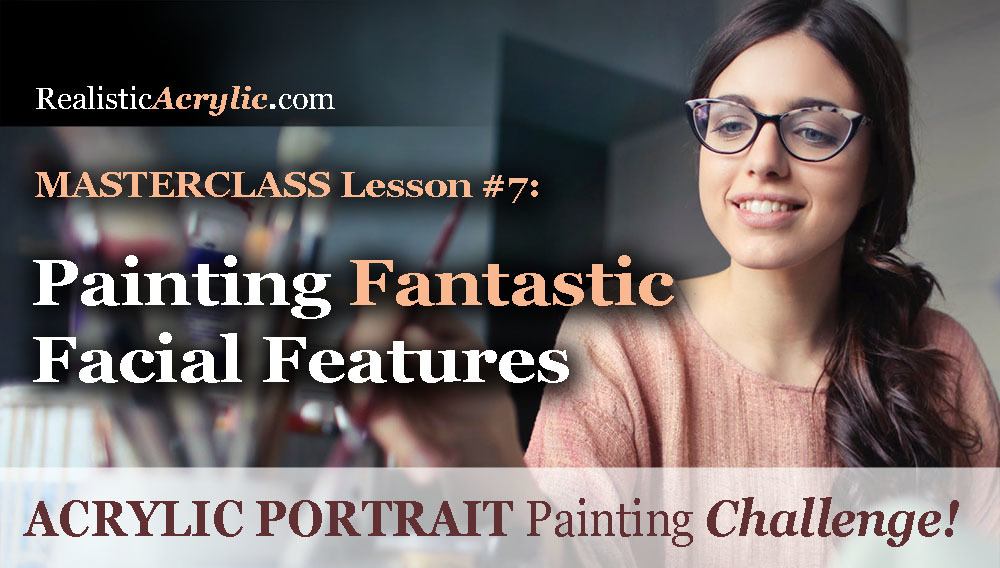
[PORTRAIT CHALLENGE] Masterclass Lesson #7: Painting Fantastic Facial Features
The Acrylic Portrait Painting Challenge Masterclass, Lesson #7, is out!
In our last lesson, I showed you how to visualize your painting as a map, and add shading and skin tones to specific spots on your portrait.
Now, in this lesson, I want to show you how to “dial-in” the facial features.
(To be upfront, I want you to know there is some video footage after Lesson 6 that I just couldn’t capture in this lesson, so it didn’t get too long for a YouTube video. All of the “in-between” BONUS videos will be posted within Realistic Acrylic All-Access Membership, after I’m finished posting these challenge lessons. The main Masterclass Lessons will be there as well as one complete course, and I will also segment them for easier viewing, since the learning interface makes that possible.)
For most of the students I serve, they do their portraits as gifts for loved ones, and on commission. So, unless you are painting only for an academic exercise, it’s important that you capture an accurate likeness of your subject.
I have painted many portraits over the years, and I can tell you from experience, it doesn’t matter how much detail I add to the painting, if the picture doesn’t look like Aunt Betty, it’s not going to sell. 🙂
So, as you are aiming for realism—that is, the accurate form, tonal values, skin tones, shading, detail, etc., you also want to work to achieve a true likeness.
Does it need to be perfect? No, just close. Usually 85-90% as accurate as the photo you’re working from (and even that is not as accurate as real life) and you’ll do well. But shoot for the 100% every time.
Let’s dive in…
Here’s what to do…
STEP ONE
- Redefine the eye-socket region.
- Redefine the eyelid folds.
- Dial-in the coloring of his eyes
STEP TWO
- Adjust the length and shape of nose (if needed) and add shading.
STEP THREE
- Add more depth to the eyes.
STEP FOUR
- Refine the mouth and mustache.
Ready to paint?
Now, before you begin…(Yes, still need to ask, because some folks are just discovering these Masterclass lessons 🙂 )
Are you registered for the challenge?
If not, register below for FREE and I’ll send you:
- a downloadable/ printable”Welcome Kit” with a Supplies List and a Palette Color Layout Guide.
- high-resolution images of the photo we’ll be painting from for this challenge.
- each new lesson that comes out in this Masterclass series.
- a link to my private Facebook group, where you can do this challenge with other artists, get feedback and help on your portrait, and not feel alone.
REGISTER TODAY. The challenge is ongoing, something you can do at your own pace. It’s not too late to enter!
Register for the Challenge!
Watch my in-depth Masterclass acrylic online tutorial below to see these steps in action.
After learning from this video, you’ll know exactly how to do it.
Make sure to watch the ENTIRE video first before diving into the painting. It will be worth it to do that. Then, I’d like you to go back and refer to whatever steps you need to as you paint. That way, you won’t miss any of the instruction and tips that will help you make this portrait your very best.
Here’s the video…
[PORTRAIT CHALLENGE] Masterclass Lesson #7: Painting Fantastic Facial Features
Moving Forward…
Thank you so much for all your effort you’ve put into doing this challenge with me and so many other artists. You’re almost there…your finished portrait is in sight.
Hey, if you’re having some challenges with your Portrait Challenge portrait, I just want to let you know, that’s natural! Painting portraits is difficult even for artists who have been doing it for years. But step-by-step instruction and encouragement from other students helps a lot. Many people in our group are doing with little to no experience, and they’re doing a knock-out job, even if they’re struggling in certain areas.
So, if you do feel stuck at this point, or find your results are less than what you expected, keep in mind this is a learning experience. You will get better as you practice painting portraits in the glazing technique, as so many others have.
That being said, if I can help in any way, please leave a comment or send me an email. I get a lot of requests, but I’ll do my very best to help. Also, make sure you join our amazing Facebook group, Realistic Acrylic Portraits, because you will receive helpful tips and encouragement from other students, some of whom are farther ahead in the portrait painting journey.
I’ll see you in our next class! What is it going to be? Painting the Final Details, Nuances, and Finishing Well. I’m excited to share that with you! Until then, be blessed in your painting and you and your family stay safe and healthy.
Yours for Better Portraits,
![]()
If you found this post helpful or encouraging, would you send it on ahead? Let others know with the share buttons below. I’d love to hear your comments. Thank you so much!
Let me know if you have any questions about the challenge that I didn’t answer. Leave your question in the comments below and I’ll get back to you!
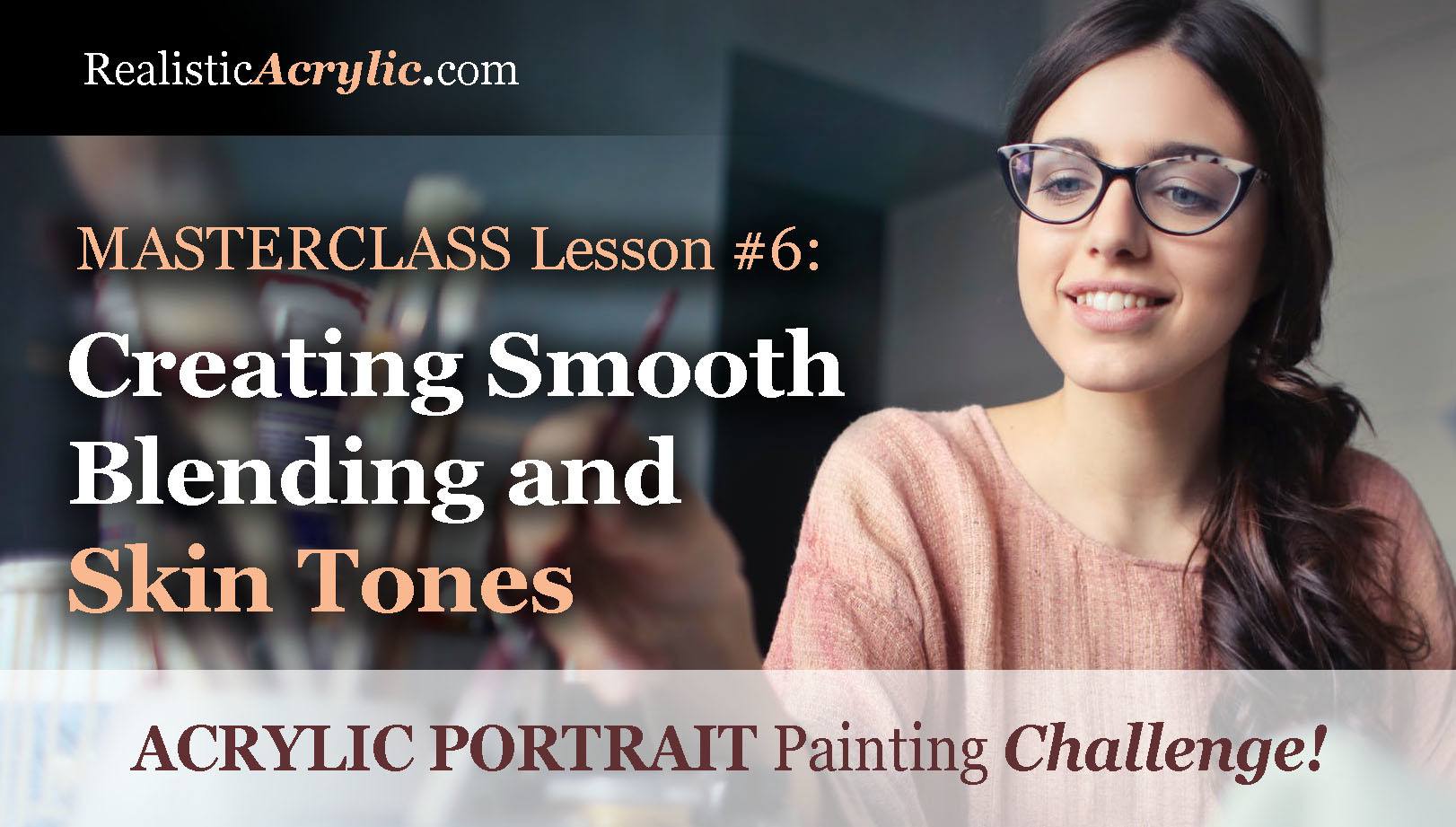
[PORTRAIT CHALLENGE] Masterclass Lesson #6: Creating Smooth Blending and Skin Tones
The Acrylic Portrait Painting Challenge Masterclass, Lesson #6, is out!
In our last lesson, I showed you how to add depth to the dark value of the hat, shadowed areas of the face, and some of the darker areas within the background.
Now that we have a good underpainting foundation in place, it’s time to transition into the “middle” portion of the painting. In other words, we’re working our way towards what the final surface of the portrait will look like.
I want to show you specifically how to create smooth blending and establish realistic skin tones.
It’s important to think of this process like outlining the boundaries of a nation, state (province) or county.
I know, we shouldn’t mix geography with art lessons, but I think this metaphor will help you understand the concept I’m trying to get across…
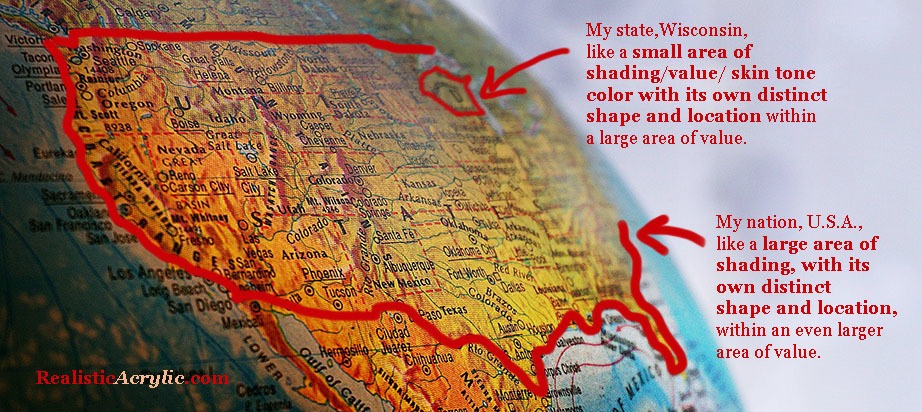
How a US map is like color, shading, and value in an acrylic portrait
I live in the state of Wisconsin, U.S.A. It has its own distinct shape and location within the United States of America. Now, the U.S.A. has its own distinct shape and location within the continent of North America.
In the same way, in a portrait, you may have a small area of value/ skin tone with its own distinct shape and location within the larger area of value/ skin tone. What you want to do is pay attention to the boundary lines on these specific shapes by studying your reference photo.
You won’t see a sharp line you will on a map, unfortunately. But you will see a marked difference where one value/ color ends and another begins.
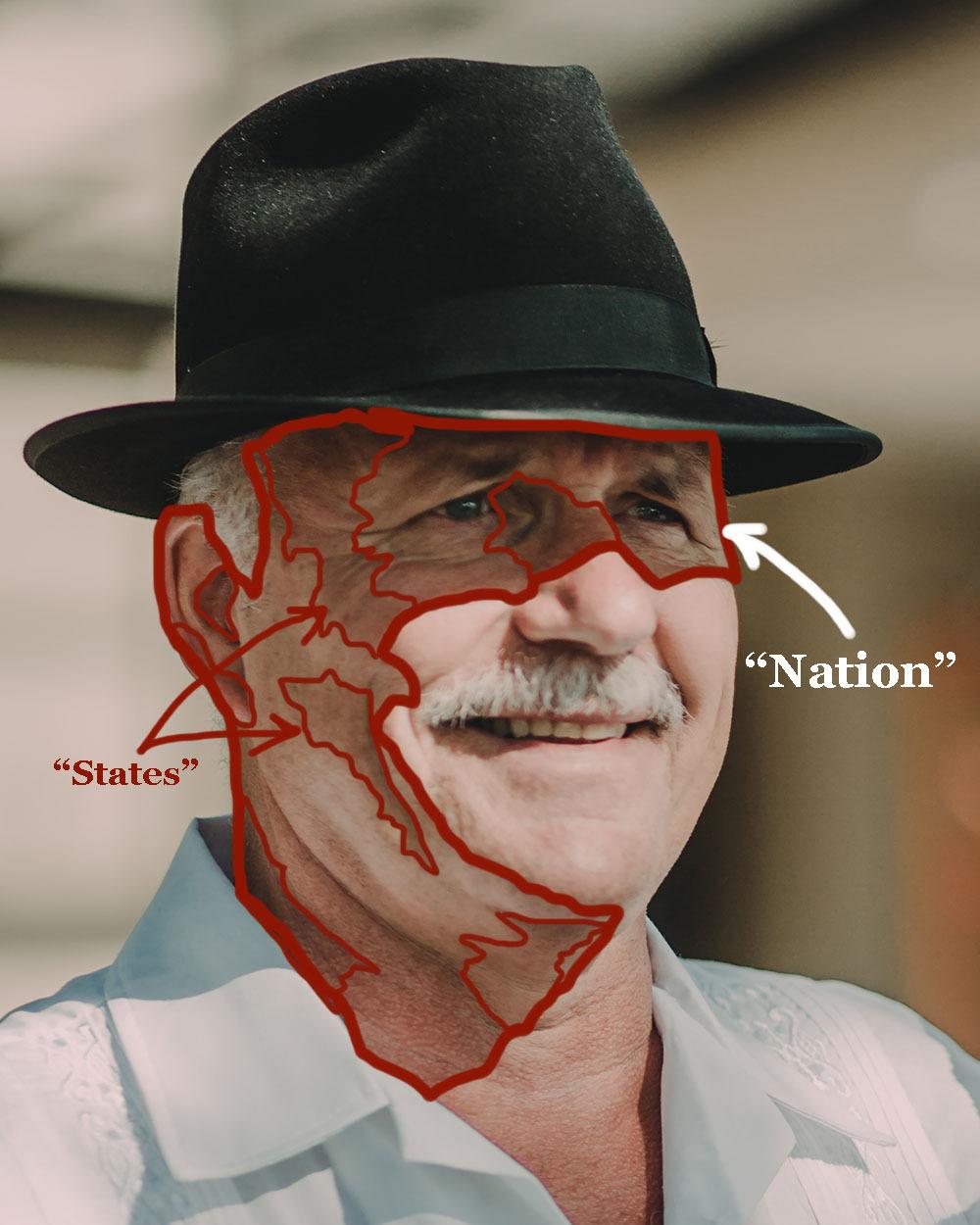
How to use the idea of a map to improve the realism on your acrylic portrait
You will see a shape emerge. Note that shape.
Then transfer what you see onto your painting. It’s as simple (and challenging!) as that.
You will see shapes within shapes within shapes. The more you can train your eyes to spot these shapes, the better you will become at realistic painting. That’s half the battle. The other half is technique: getting the paint to do what you want it to do.
This concept of “Nations and States” is powerful once you get a hold of it and use it regularly in your acrylic portrait painting! Now, let’s get onto the lesson…
What we want to do at this stage:
Begin the process of adding smooth shading and skin tones throughout the portrait.
We will be adding:
- a large “warming” glaze to the entire shadow area of the man’s face.
- glaze on the highlighted area of the face, adding depth and the beginning of skin tones, so the area is not just plain white or off white.
- small glazes (“states”) on the shadow side (“nation”) of the face to further define the pinkish skin tones.
We will do this using the acrylic glazing technique, where we mix a TINY amount of acrylic paint into a LARGE amount of clear acrylic matte medium. It’s best to go very, very light when you start your painting. You should just barely see a difference. However, at this stage you will getting a bit more opaque, because you have enough layers down already to give you some smoothness in the overall appearance.
Also, as always, make sure you rinse your brush off thoroughly between glazes. Any extra water in the heel of the brush may cause your glazes to drip or get streaky.
Here’s how to do it:
STEP ONE
- First, mix the “warming glaze” for the shadow side of the face: Use raw sienna and mix with a large amount of matte medium (10% paint to 90% medium) as shown in the video lesson. “Scoop” a large amount of glaze onto your 3/4″or 1″ flat brush. A few of the glazes will get a little darker, with ratios of as much as 30% paint to 70% medium. Make sure you watch the video to know where and when to change the ratio. “Next, glaze
- Glaze on the highlight side of face, to “tie-in” with the shadow side, develop mid-tones and create depth: Use raw sienna and organic pyrrole orange (or a cadmium orange) and mix it 5% paint to 95% matte medium. Test the glaze and see if you need to add more pigment or more medium. You should just barely see a difference in what you apply.
- Add small glazes in specific locations (“states”) on the shadow side of face using organic pyrrole orange, raw sienna, and a bit of alizarine crimson if needed to darken the glaze without adding too much chromatic intensity.
STEP TWO
- Add another layer of shading to the man’s hat and the background: Use raw umber dark, ultramarine blue, and a touch of alizarine crimson. How much of each? It depends on what the hat looks like right now as you paint. Is it too bluish? Add more raw umber dark. Is it too brownish? Add more ultramarine blue. Is it too greenish? Add alizarine crimson—just a pinch.
- Take the same glaze you used for the hat and add some shadows below his hat: Because it is right underneath the brim of his hat, the shadows will be quite dark in value. Add a bit of raw umber dark (or raw umber) and a bit of alizarin crimson if necessary to warm up the glaze, especially as you transition into the lighter parts of the skin tones.
- Clean off your brush and apply a blue glaze to the highlighted areas in his shirt: Mix ultramarine blue and phthalo blue (just a bit—it’s a VERY strong pigment) into a large amount of matte medium (95% to 5%, ratio to start with, and test to see if you need to change it) We want to bridge the gap between the shadows and the highlights, adding much-needed depth to this area of the painting.
STEP THREE
- Repeat Step 1, with slight adjustments. Follow the video for more detailed instruction.
Ready to paint?
Now, before you begin…(Yes, still need to ask, because some folks are just discovering these Masterclass lessons 🙂 )
Are you registered for the challenge?
If not, register below for FREE and I’ll send you:
- a downloadable/ printable”Welcome Kit” with a Supplies List and a Palette Color Layout Guide.
- high-resolution images of the photo we’ll be painting from for this challenge.
- each new lesson that comes out in this Masterclass series.
- a link to my private Facebook group, where you can do this challenge with other artists, get feedback and help on your portrait, and not feel alone.
REGISTER TODAY. The challenge is ongoing, something you can do at your own pace. It’s not too late to enter!
Register for the Challenge!
Watch my in-depth Masterclass acrylic online tutorial below to see these steps in action.
After learning from this video, you’ll know exactly how to do it.
Make sure to watch the ENTIRE video first before diving into the painting. It will be worth it to do that. Then, I’d like you to go back and refer to whatever steps you need to as you paint. That way, you won’t miss any of the instruction and tips that will help you make this portrait your very best.
Here’s the video…
[PORTRAIT CHALLENGE] Masterclass Lesson #6: Creating Smooth Blending and Skin Tones
Moving Forward…
If you have gotten this far in the challenge, I’m proud of you! It’s not easy to try something new, especially during a challenging time (COVID-19 as I write) but you are making a difference in your own life by developing the talent God gave you and you will be making a difference in others lives when you freely share the beautiful artwork you create with those you love or want to impact.
I’ll see you in our next class! What is it going to be? Painting fantastic facial features. I’m excited to share that with you! Until then, be blessed in your painting and you and your family stay safe and healthy.
Yours for Better Portraits,
![]()
If you found this post helpful or encouraging, would you send it on ahead? Let others know with the share buttons below. I’d love to hear your comments. Thank you so much!
Let me know if you have any questions about the challenge that I didn’t answer. Leave your question in the comments below and I’ll get back to you!
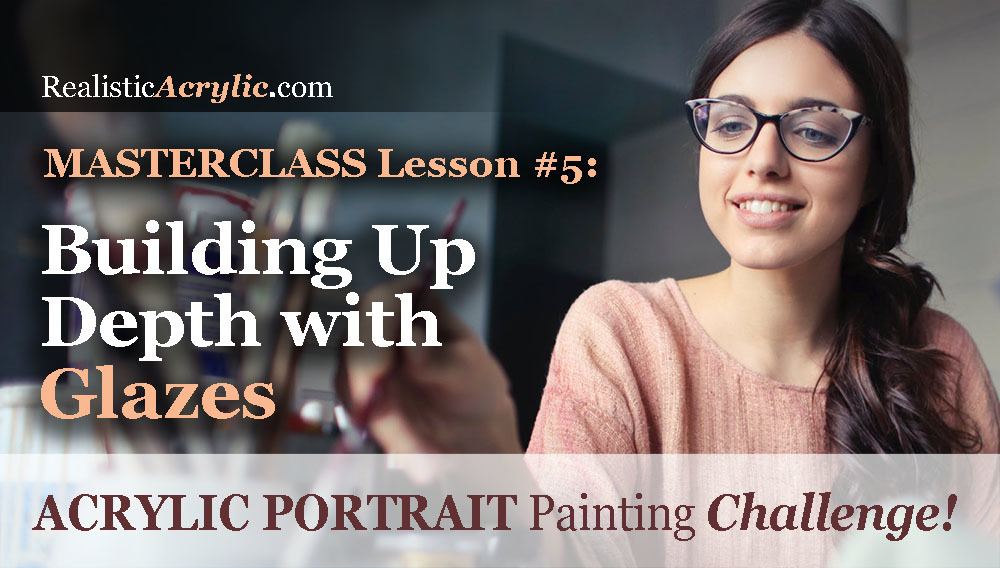
[PORTRAIT CHALLENGE] Masterclass Lesson #5: Building up Depth With Glazes
The Acrylic Portrait Painting Challenge Masterclass Lesson #5 is out!
In our last two lessons, I showed you how to cover your entire canvas with a series of three glazes covering the entire surface of the canvas as one layer.
Now, with this lesson, I’ll show you how to continue the process of adding layers on top of layers. We want to “rotate,” going back to the first glaze we did, and go on top of it with another glaze. And then to the next, and so on. Remember volleyball? It’s kind of like that. Every person gets a turn.
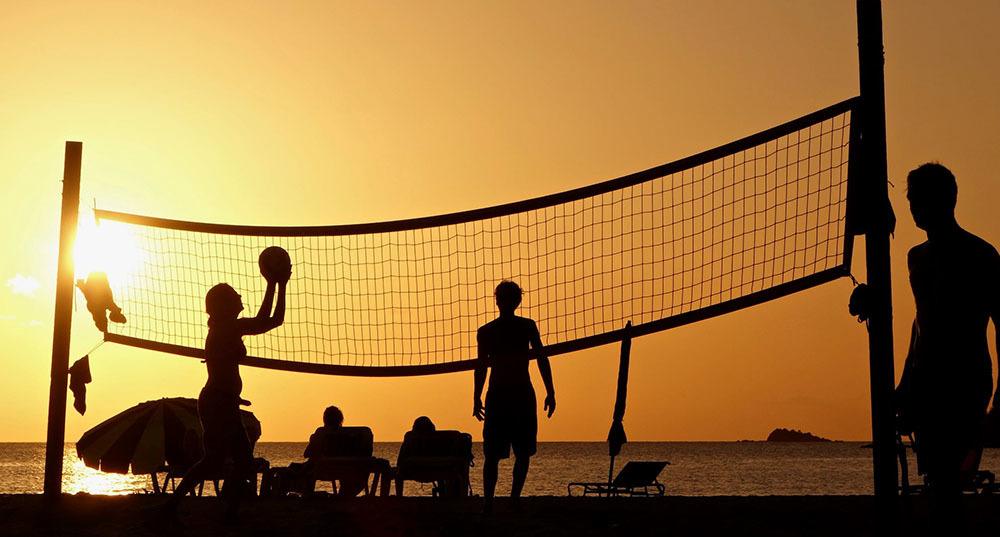
Volleyball rotation like rotating glaze layers in your acrylic portrait
Here in the portrait using the acrylic glazing technique, every part of the picture gets a turn, having another glaze added to it. (There are some times when we break this rule, and I’ll show you that in the video lesson)
Here is where I’m at in the portrait, prior to this video lesson, after the work I did on Lesson #4.
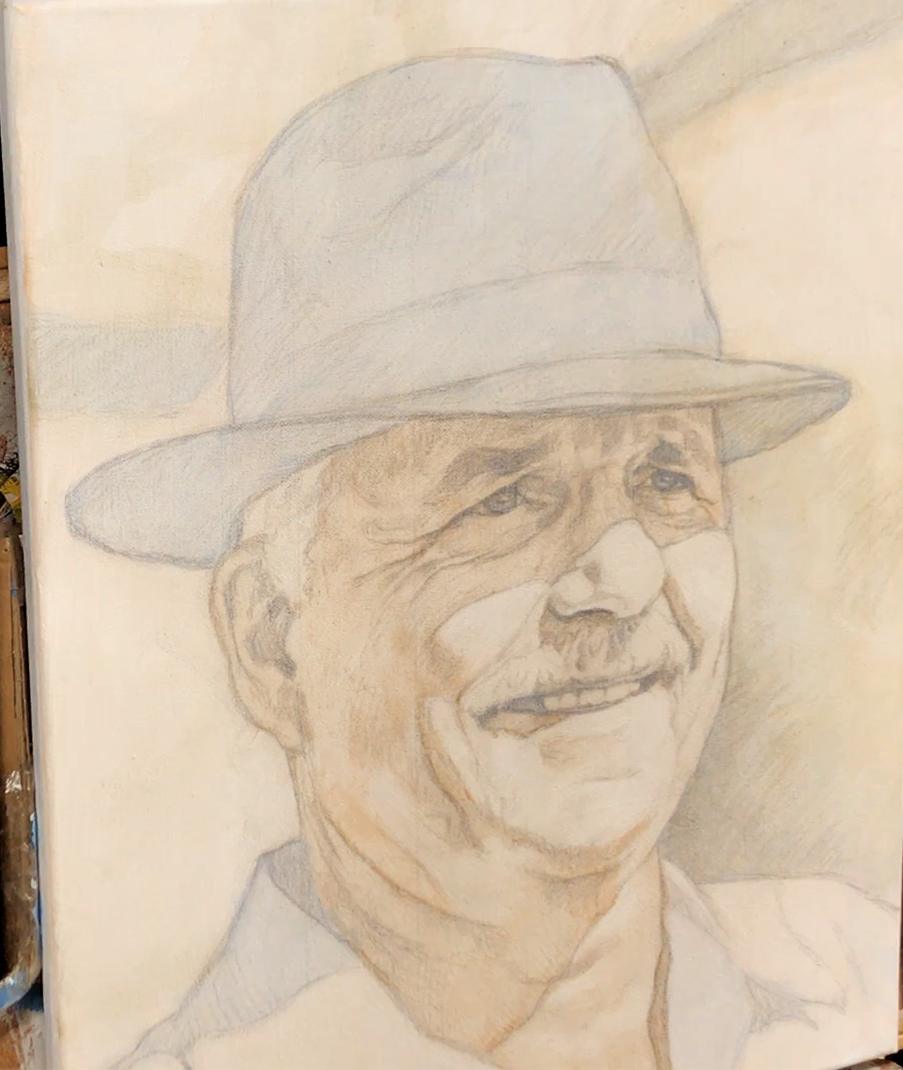
Acrylic portrait painting challenge example in progress using the acrylic glazing technique, 16 x 20, acrylic on canvas by artist and instructor Matt Philleo
What we want to do at this stage:
Since we already have locked in the major differences in the color scheme and tonal value very simply, now we want to add more complexity to the painting.
We will be adding:
- depth to the dark value of the hat
- shadowed areas of the face
- and some of the darker areas within the background.
We will do this using the acrylic glazing technique, where we mix a TINY amount of acrylic paint into a LARGE amount of clear acrylic matte medium. It’s best to go very, very light when you start your painting. You should just barely see a difference.
Also, make sure you rinse your brush off thoroughly between glazes. Any extra water in the heel of the brush may cause your glazes to drip or get streaky.
Here’s how to do it:
- Mix your Glaze for Hat: Use small, fairly equal amounts of ultramarine blue and raw umber dark, and mix with a large amount of matte medium (5% paint to 95% medium) as shown in the video lesson. “Scoop” a large amount of glaze onto your 3/4″or 1″ flat brush. A few of the glazes will get a little darker, with ratios of as much as 30% paint to 70% medium. Make sure you watch the video to know where and when to change the ratio.
- Apply the Glaze: Start on the left-hand side of hat and apply the glaze with firm pressure to cut along the edges. Spread the paint out toward the right, keeping a wet edge. Flip the brush over to make use of the paint that is on both sides.
- Smooth Out the Glaze: Use diagonal criss-cross strokes to blend the glaze out rapidly. Use very light pressure at the end, just barely grazing your brush across the top. Don’t overwork the glaze. TIP: It dries quickly. If it starts to get blotchy or tacky, just leave it alone, or you’ll make it worse. You will be able to smooth it out later with more layers on top.
- See Where Else You Can Employ the Glaze: Because you don’t want to waste the paint and medium, and to save time, use this same glaze on the background, adding as shown in the video lesson.
- Add a Shadow Glaze to the Face. What we want to do is add a shadow on top of the shadow. Start at the left side of his face, underneath the hat, and cut up along the edge, working your way right, and bring the glaze down into the forehead wrinkles as I show in the video. Follow the distinct shapes and patterns that you see on your reference photo.
You will repeat this process another time, with some variations.
Ready to paint?
Now, before you begin (yes, I have to ask you again, just in case 🙂 )…
Are you registered for the challenge?
If not, register below for FREE and I’ll send you:
- a downloadable/ printable”Welcome Kit” with a Supplies List and a Palette Color Layout Guide.
- high-resolution images of the photo we’ll be painting from for this challenge.
- each new lesson that comes out in this Masterclass series.
- a link to my private Facebook group, where you can do this challenge with other artists, get feedback and help on your portrait, and not feel alone.
REGISTER TODAY. The challenge is ongoing, something you can do at your own pace. It’s not too late to enter!
Register for the Challenge!
Watch my in-depth Masterclass acrylic online tutorial below to see these steps in action.
After learning from this video, you’ll know exactly how to do it.
Make sure to watch the ENTIRE video first before diving into the painting. It will be worth it to do that. Then, I’d like you to go back and refer to whatever steps you need to as you paint. That way, you won’t miss any of the instruction and tips that will help you make this portrait your very best.
Here’s the video…
[PORTRAIT CHALLENGE] Masterclass Lesson #5: Building up Depth With Glazes
Moving Forward…
Excellent job staying with me and the other artists for this challenging portrait! The acrylic glazing technique takes some getting used to, but once you really “get it” you will be able to paint with a freedom, confidence, and sense of realism that will keep you encouraged to keep on painting more and more.
In our next class, I’ll show you how to add more glazes and build up the skin tones. It’s something so many artists aspire to: create those lifelike skin tones that just look real. And now with a good foundation in place, we can do it!
I’ll see you in our next class! Until then be blessed in your painting and you and your family stay safe and healthy.
Yours for Better Portraits,
![]()
If you found this post helpful or encouraging, would you send it on ahead? Let others know with the share buttons below. I’d love to hear your comments. Thank you so much!
Let me know if you have any questions about the challenge that I didn’t answer. Leave your question in the comments below and I’ll get back to you!
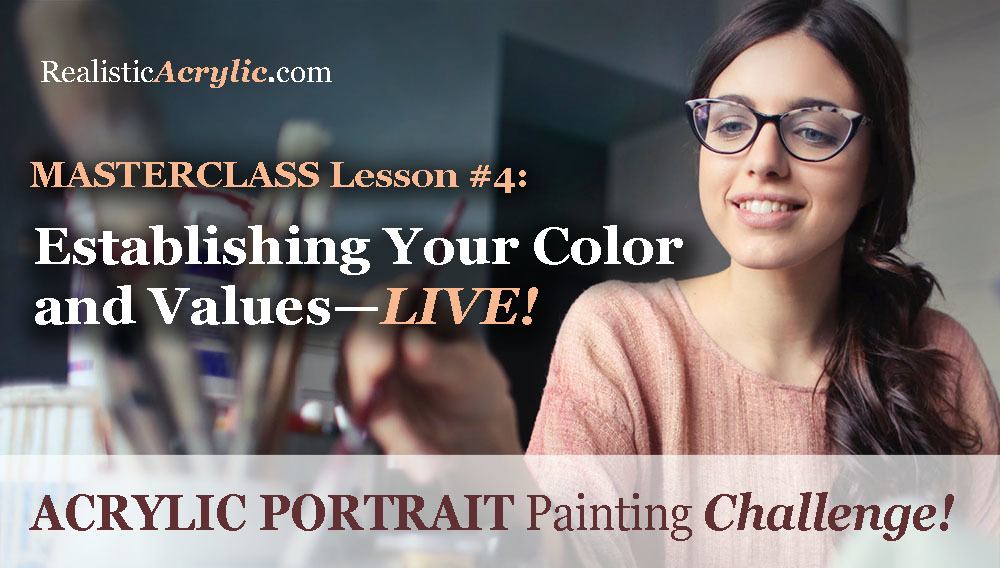
[PORTRAIT CHALLENGE] Masterclass Lesson #4, LIVE: Establishing Your Color and Values
For a change of pace, we did the Acrylic Portrait Challenge Masterclass Lesson #4 as a LIVE class, and I’m excited to share it with you!
In our last lesson, I showed you how to prepare your canvas for painting by whiting out the grid lines, sealing in and muting the sketch, and preparing your palette.
Finally, we began the actual painting process with a glaze of ultramarine blue (a glaze is a small amount of acrylic paint mixed into a large amount of clear acrylic medium, usually matte medium).
Now, in this lesson (recorded LIVE), I will show you how to add the next two glazes, which will nearly cover the entire canvas with one layer.
Whereas the sketch is the actual foundation for the painting, this first layer is very important. It is like the floor joists when a house is built. The rest of the structure attaches to that, and so housebuilders take extra time to make sure they do it correctly. If they don’t they’ll end up with a structure that will end up sagging years, or even worse, collapsing!
In the same way, we want to make sure we have this first layer done correctly. Don’t feel nervous about it. You can still fix a painting that hasn’t been started correctly, and end up with a truly realistic acrylic portrait. It just will take you more time and effort to correct, and so it’s best to avoid that hassle if possible.
What we want to do at this stage:
Our main goal right now is to establish the main value and color scheme of the portrait, simultaneously. We want to “lock-in” the contrast between the lights and dark values, paying attention to their specific edges, boundaries, and shapes. If you did the sketch according to Lesson #2, then you will know almost exactly where to place your initial glazes, because your sketch tells you where to put it.
We also want to observe the major differences in color within the reference photo, simplify it to “warm and cool” tones and use our inital glazes to plot that out. Then, future layers will be added on top of them, getting more and more complex as we go along.
But the initial glaze will serve us well.
It’s like how a major highway was often once a foot trail, then a cowpath, then a dirt road, then a paved road, and finally a highway. It’s a lot easier to upgrade a road, than to try to build a new one. You’d have to bulldoze trees, cut through rocks, level the land, and even remove homes if necessary.

In the same way, with the glazing technique, we are getting the compounded effect of each previous layer adding richness and depth to the ones that come after them. That’s why you want to start off right.
Again, as I’ve said in the last lesson: begin the painting lightly. Much lighter than you think. And certainly more than you’re used to painting, if you’ve painted for a while. If you just barely see a difference in this first layer, you’re doing it exactly right!
Let’s dive into the process…
Here’s how to do it:
- Mix your Glaze for the Skin Tone Foundation Layer: Use a small amount of burnt sienna and raw umber dark, and mix with a large amount of matte medium (5% paint to 95% medium) as shown in the video lesson. “Scoop” a large amount of glaze onto your 3/4″or 1″ flat brush.
- Apply the Glaze: Start on the left-hand side of the man’s face, and apply the glaze with firm pressure to cut along the edge of the ear, neck, and along the collar. Spread the paint out toward the right, keeping a wet edge. Flip the brush over to make use of the paint that is on both sides.
- Smooth Out the Glaze: Use diagonal criss-cross strokes to blend the glaze out rapidly. Use very light pressure at the end, just barely grazing your brush across the top. Don’t overwork the glaze. TIP: It dries quickly. If it starts to get blotchy or tacky, just leave it alone, or you’ll make it worse. You will be able to smooth it out later with more layers on top.
- Mix the Glaze for the Background Foundation Layer: Now, if you followed my steps from Lesson #3, you should have an ultramarine blue glaze already on the background’s darkest values. This glaze will go on top of that, and will start the basic color for the mid-tone area in the right direction. Take a small amount of raw sienna as the base, smaller amount of raw umber (or raw umber dark) and and even smaller amount of ultramarine blue, and mix them slowly into the matte medium as I show in the video.
- Add the Glaze and Smooth it Out. Apply this similarly as the skin tone glaze, but this time, you only need to cut up along the edge of objects with very light tonal value, such as the shirt or the illuminated portion of the man’s face. The glaze can go on top of the hat, because the final tonal value of that area will be so dark, so there’s no need to worry about trying to “keep within the lines” there.
Ready to paint?
Now, before you begin (yes, I have to ask you again, just in case 🙂 )…
Are you registered for the challenge?
If not, register below for FREE and I’ll send you:
- a downloadable/ printable”Welcome Kit” with a Supplies List and a Palette Color Layout Guide.
- high-resolution images of the photo we’ll be painting from for this challenge.
- each new lesson that comes out in this Masterclass series.
- a link to my private Facebook group, where you can do this challenge with other artists, get feedback and help on your portrait, and not feel alone.
REGISTER TODAY. The challenge is ongoing, something you can do at your own pace. It’s not too late to enter!
Register for the Challenge!
Watch my in-depth Masterclass acrylic online tutorial below to see these steps in action.
After learning from this video, you’ll know exactly how to do it.
Make sure to watch the ENTIRE video first before diving into the painting. It will be worth it to do that. Then, I’d like you to go back and refer to whatever steps you need to as you paint. That way, you won’t miss any of the instruction and tips that will help you make this portrait your very best.
Here’s the video…
[PORTRAIT CHALLENGE] Masterclass Lesson #4, LIVE: Establishing Your Color and Values
Moving Forward…
If you made it this far, congratulations! It’s not easy to start a painting so light, when your natural instinct is paint thick and dark right away. So, if you’ve followed my steps as best you can, high fives and hat’s off to you! Stick with this process, and you will be able to paint more confidently and realistically than you ever have before.
Now, since we have the complete glaze foundation work done on the painting—the hat, the face, the shirt, the background all has paint on it, we can move on and add more and more glazes—building up richness, depth, and detail. The painting will look more and more amazing each time we add another layer. There may be a few times where you’ll hit a few rough spots, but by God’s grace, I’ll show you how to navigate those challenges and finish your portrait well.
I’ll see you in our next class! Until then be blessed in your painting and may God guide your every brushstroke!
Yours for Better Portraits,
![]()
If you found this post helpful or encouraging, would you send it on ahead? Let others know with the share buttons below. I’d love to hear your comments. Thank you so much!
Let me know if you have any questions about the challenge that I didn’t answer. Leave your question in the comments below and I’ll get back to you!
